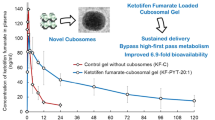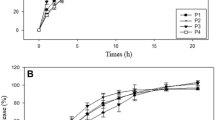Abstract
The pharmacokinetic and pharmacodynamic properties of FK613, a novel indolyl piperidine derivative, were investigated after oral administrations of 5, 10 and 20 mg in hard gelatin capsules to healthy male volunteers. FK613 was rapidly and almost completely absorbed, and >89% was recovered in the urine as the unchanged form. The urinary excretion of FK613 was linearly correlated with plasma concentration and its low water solubility was the main concern regarding the safety. In another experiment using a double-blind crossover design, in which 0 (placebo), 5 and 20 mg FK613 were administered to determine the plasma concentration-effect relationship, suppression of the intradermal histamine-induced skin reaction by FK613 was observed. Thus, the maintenance of a plasma concentration of FK613 in the range of 80–250 ng · ml-1 was recommended to ensure the suppression of histamine-induced wheal by >50% and not to exceed the solubility in urine. To achieve this, a new hydrogel-type formulation of FK613 was developed, with the aim both of delaying its absorption, so as to suppress the sharp rise in plasma concentration, and of maintaining the effective concentration for a longer period of time. This formulation was administered after meals at the doses of 20, 30, 40, 50 and 60 mg, and at repeated doses of 40 mg twice daily for 6.5 days to evaluate the pharmacokinetics and safety in healthy subjects. The area under the plasma concentration curve increased linearly with dose, whereas maximum plasma concentration (Cmax) tended to peak as dose increased, indicating the desirable properties of this formulation. Although Cmax exceeded 250 ng/ml at doses of 30 mg or more, no urinary crystal formation was observed on careful inspection of urine.
Similar content being viewed by others
References
Lewis T (1927) The blood vessels of the human skin and their responses. Shaw & Sons, London.
Kerp L, Tie PN (1966) Pruefung des Antihistamins HS 592 am Histamin-bzw. “48/80”-Erythem und bei Patienten mit allergischen Sofort-reaktionen. Med Welt 51:2794–2798.
Joubert L, Gaut Z, Abrams WB (1969) A new approach of the use of histamine skin tests in the study of antihistamine drugs. Clin Pharmacol Ther 10:250–257.
Uematsu T, Takiguchi Y, Mizuno A, Sogabe K, Nakashima M (1987) Application of thermography to the evaluation of the histamine skin test in man. J Pharmacol Methods 18:103–110.
Simons FER, McMillan JL, Simons KJ (1980) A double-blind, single-dose, crossover comparison of cetirizine, terfenadine, loratadine, astemizole, and chlorpheniramine versus placebo: suppressive effects on histamine-induced wheals and flares during 24 hours in normal subjects. J Allergy Clin Immunol 86:540–547.
Melander A (1978) Influence of food on the bioavailability of drugs. Clin Pharmacokinet 3:337–351.
Yamaoka K, Tanigawara Y, Nakagawa T, Uno T (1981) A pharmacokinetic analysis program (MULTI) for microcomputer. J Pharmacobiodyn 4:879–885.
Holford NH, Sheiner LB (1981) Understanding the dose-effect relationship: clinical application of pharmacokinetic-pharmacodynamic models. Clin Pharmacokinet 6:429–453.
Woodword JK (1990) Pharmacology of antihistamines. J Allergy Clin Immunol 86:606–612.
Sheffer AL, Fink JN (1991) Asthma '90. Immunopharmacologic update. J Allergy Clin Immunol 88:303–321.
Cassidy J, Berner B, Chan K, John V, Toon S, Holt B, Rowland M (1993) Human transbuccal absorption of diclofenac sodium from a prototype hydrogel delivery device. Pharmac Res 10:126–129.
Robertson WG, Peacock M, Marshall RW, Marshall DH, Nordin BE (1976) Saturation-inhibition index as a measure of the risk of calcium oxalate stone formation in the urinary tract. N Engl J Med 294:249–252.
Woelfel A, Kaplan RA, Pak CY (1977) Effect of hydrochlorothiazide therapy on the crystallization of calcium oxalate in urine. Metabolism 26:201–205.
Nicar MJ, Hill K, Pak CY (1983) A simple technique for assessing the propensity for crystallization of calcium oxalate and brushite in urine from the increment in oxalate or calcium necessary to elicit precipitation. Metabolism 32:906–910.
Author information
Authors and Affiliations
Rights and permissions
About this article
Cite this article
Uematsu, T., Nagashima, S., Inaba, H. et al. Design of a suitable formulation of FK613, a novel antiallergic agent, based on its pharmacokinetic and pharmacodynamic properties in healthy subjects. Eur J Clin Pharmacol 49, 279–284 (1996). https://doi.org/10.1007/BF00226328
Received:
Accepted:
Published:
Issue Date:
DOI: https://doi.org/10.1007/BF00226328




